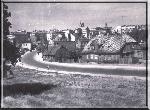 Street names often contain a lot of information. Keeping topographical or historical names can cast light on the history and development of the town. Many streets in Mława derive their names from the names of the cities they lead to e.g.: Warszawska St., Płocka St., Niborska (formerly- now Padlewskiego) St. and Działdowska St. Other street names often portray their appearance or character e.g.: Długa St (Long St) which, in the past, corresponded to its name. Along Graniczna St (Border St) there were former city borders. Many street names have been replaced by the new ones which often do not have anything in common with the town e.g. Żeromskiego St was previously called Ogrodowa St (Garden St) because of the municipal park spreading along this street. Former Klasztorna St (Monastery St- there was a monastery there) is now 3 Maja St (3rd May St). Also the name of Działdowska Street has been changed and now it is called Żwirki St; and Wilcza St (Wolf St) has been changed into Wigury St. Some of the streets had their names changed but they kept their own specific character Street names often contain a lot of information. Keeping topographical or historical names can cast light on the history and development of the town. Many streets in Mława derive their names from the names of the cities they lead to e.g.: Warszawska St., Płocka St., Niborska (formerly- now Padlewskiego) St. and Działdowska St. Other street names often portray their appearance or character e.g.: Długa St (Long St) which, in the past, corresponded to its name. Along Graniczna St (Border St) there were former city borders. Many street names have been replaced by the new ones which often do not have anything in common with the town e.g. Żeromskiego St was previously called Ogrodowa St (Garden St) because of the municipal park spreading along this street. Former Klasztorna St (Monastery St- there was a monastery there) is now 3 Maja St (3rd May St). Also the name of Działdowska Street has been changed and now it is called Żwirki St; and Wilcza St (Wolf St) has been changed into Wigury St. Some of the streets had their names changed but they kept their own specific character |
| Napoelońska St leads to Mława's quarter called Wólka. The street is a part of działdowski tract coming straight from Mława and leading to Działdowo through Mławka hills and two villages: Iłowo and Kisiny. The street belongs to the historical monuments of Mława. Its name was created around 1920 on the initiative of rev Krajewski. Previously Działdowska St was called "Piaski" (Sands) because of a small village that was scattered all over the nearby sandy land. Rev. Krajewski suggesting the name Napoleońska St (Street of Napoleon) had in mind the way that victorious Napoleon forces under the command of marshal Bernadotte took to enter Mława. |
| The name Zabrody has existed undoubtedly since the dawn of Mława. It means that the Seracz River used to be bigger a long time ago than it is now and that it was a major obstacle in transportation on the way from Mława. So a ford had to be created for a more convenient passage cross the river. After the ford had been made, the land behind it started to be called "Zabrody" (Behind the ford). In 1429 Mława was given a part of this land and it was included into the starosty (i.e. royal estate). Over there starosty buildings were built. Until 1914 the family of Lelewel (close relatives of Joachim Lelewel) used to live there. |
| The name Działdowska St disappeared about 1930. But as doctor Olszewski writes "someday it will reappear". He was also sure that there would never be Koszutski Street (Koszutski was Mława's mayor, the author of this change). Działdowska St started in the marketplace as the main road to Działdowo and turned into present Żwirki St. Działdowska Street's name was created before 1400. This way the Tartars were running away to Lithuania and also fugitives from duke Witold's regiments from Grunwald were fleeing. One side of Działdowska St from 1429 used to be so called "Wójtostwo" which was a grange separated from town lands for the village mayor. The grange land extended from Napoleońska St to Studzieniec. |
| Niborska St. was originally a zigzag road coming from the marketplace towards Niborg. (currently Nidzica). After 100 metres it met a natural obstacle which was the River Seracz. The pass through the river was probably formed around the year 1300 after the fortress foundation by the Teutonic Knights in Niborg. Until 1800 behind the river there was an open country. |
| Warszawska St's name (Warsaw St) goes back to the year 1570. There is no information about its original name. The street was already inhabited in distant times and it was a busy part of the town. For centuries the Jews had settled there and slowly the street became a Jewish ghetto outside of which they were not allowed to settle down. |
Old Streets
/
